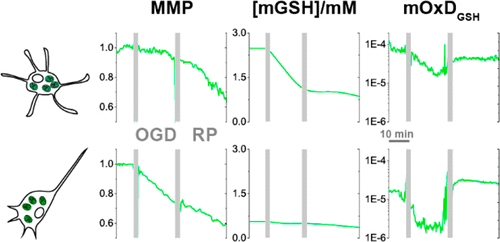当前位置:
X-MOL 学术
›
ACS Chem. Neurosci.
›
论文详情
Our official English website, www.x-mol.net, welcomes your feedback! (Note: you will need to create a separate account there.)
Mitochondrial GSH Systems in CA1 Pyramidal Cells and Astrocytes React Differently during Oxygen-Glucose Deprivation and Reperfusion
ACS Chemical Neuroscience ( IF 5 ) Pub Date : 2017-11-27 00:00:00 , DOI: 10.1021/acschemneuro.7b00369 Bocheng Yin 1 , Germán Barrionuevo 2 , Stephen G. Weber 1
ACS Chemical Neuroscience ( IF 5 ) Pub Date : 2017-11-27 00:00:00 , DOI: 10.1021/acschemneuro.7b00369 Bocheng Yin 1 , Germán Barrionuevo 2 , Stephen G. Weber 1
Affiliation

|
Pyramidal cells and astrocytes have differential susceptibility to oxygen-glucose deprivation and reperfusion (OGD-RP). It is known that excessive reactive oxygen species (ROS) in mitochondria initiates cell death, while glutathione (GSH) is one of the major defenses against ROS. Although it is known that astrocytes contain a higher concentration of GSH than neurons, and that astrocytes can provide neurons with GSH, we are unaware of a detailed and quantitative examination of the dynamic changes in the mitochondrial GSH system in the two cell types during OGD-RP. Here, we determined mitochondrial membrane potential and the degrees of oxidation of the mitochondrially targeted roGFP-based sensors for hydrogen peroxide (OxDP) and GSH (OxDG). We also developed a method to estimate the mitochondrial GSH (mGSH) concentration in single cells in the CA1 region of organotypic hippocampal slice cultures at several time-points during OGD-RP. We find that mitochondrial membrane potential drops in pyramidal cells during OGD while it is relatively stable in astrocytes. In both types of cell, the mitochondrial membrane potential decreases during RP. During OGD-RP, mitochondrial peroxide levels are the same. Astrocytic mGSH is more than four times higher than pyramidal cell mGSH (3.2 vs 0.7 mM). Astrocytic mGSH is drained from mitochondria during OGD, whereas in pyramidal cells it remains fairly constant. OxDGSH prior to and during OGD is lower (less oxidized) in pyramidal cells than in astrocytes, but the two nearly converge during RP. The larger changes of redox status in the GSH system in pyramidal cells than astrocytes is an upstream sign of the higher mortality of the pyramidal cells after facing an insult. The pattern of [mGSH] changes in the two cell types could be recognized as another mechanism by which astrocytes protect neurons from transient, extreme conditions.
中文翻译:

氧-葡萄糖剥夺和再灌注期间CA1锥体细胞和星形胶质细胞中的线粒体GSH系统反应不同。
金字塔形细胞和星形胶质细胞对氧葡萄糖剥夺和再灌注(OGD-RP)的敏感性不同。众所周知,线粒体中过量的活性氧(ROS)会引发细胞死亡,而谷胱甘肽(GSH)是抵抗ROS的主要防御手段之一。尽管已知星形胶质细胞比神经元包含更高的GSH浓度,并且星形胶质细胞可以为神经元提供GSH,但我们没有意识到在OGD-期间两种细胞类型中线粒体GSH系统动态变化的详细和定量检查。 RP。在这里,我们确定了针对过氧化氢(OxD P)和GSH(OxD G)。我们还开发了一种方法,可以在OGD-RP期间的几个时间点估算器官型海马切片培养物CA1区单细胞中的线粒体GSH(mGSH)浓度。我们发现在OGD期间锥体细胞的线粒体膜电位下降,而在星形胶质细胞中则相对稳定。在两种类型的细胞中,RP期间线粒体膜电位均降低。在OGD-RP期间,线粒体过氧化物的含量是相同的。星形细胞mGSH比锥体细胞mGSH高四倍以上(3.2 vs 0.7 mM)。在OGD期间,星形细胞mGSH从线粒体中排出,而在锥体细胞中它保持相当恒定。氧化型谷胱甘肽在锥体细胞中,OGD之前和期间的OGD较低(氧化程度较低),比星形胶质细胞低,但在RP期间,两者几乎会聚。与星形胶质细胞相比,锥体细胞中GSH系统中氧化还原状态的变化更大,这是锥体细胞面对损伤后死亡率较高的上游信号。两种细胞类型中[mGSH]变化的模式可以被认为是星形胶质细胞保护神经元免受瞬态,极端条件影响的另一种机制。
更新日期:2017-11-27
中文翻译:

氧-葡萄糖剥夺和再灌注期间CA1锥体细胞和星形胶质细胞中的线粒体GSH系统反应不同。
金字塔形细胞和星形胶质细胞对氧葡萄糖剥夺和再灌注(OGD-RP)的敏感性不同。众所周知,线粒体中过量的活性氧(ROS)会引发细胞死亡,而谷胱甘肽(GSH)是抵抗ROS的主要防御手段之一。尽管已知星形胶质细胞比神经元包含更高的GSH浓度,并且星形胶质细胞可以为神经元提供GSH,但我们没有意识到在OGD-期间两种细胞类型中线粒体GSH系统动态变化的详细和定量检查。 RP。在这里,我们确定了针对过氧化氢(OxD P)和GSH(OxD G)。我们还开发了一种方法,可以在OGD-RP期间的几个时间点估算器官型海马切片培养物CA1区单细胞中的线粒体GSH(mGSH)浓度。我们发现在OGD期间锥体细胞的线粒体膜电位下降,而在星形胶质细胞中则相对稳定。在两种类型的细胞中,RP期间线粒体膜电位均降低。在OGD-RP期间,线粒体过氧化物的含量是相同的。星形细胞mGSH比锥体细胞mGSH高四倍以上(3.2 vs 0.7 mM)。在OGD期间,星形细胞mGSH从线粒体中排出,而在锥体细胞中它保持相当恒定。氧化型谷胱甘肽在锥体细胞中,OGD之前和期间的OGD较低(氧化程度较低),比星形胶质细胞低,但在RP期间,两者几乎会聚。与星形胶质细胞相比,锥体细胞中GSH系统中氧化还原状态的变化更大,这是锥体细胞面对损伤后死亡率较高的上游信号。两种细胞类型中[mGSH]变化的模式可以被认为是星形胶质细胞保护神经元免受瞬态,极端条件影响的另一种机制。


























 京公网安备 11010802027423号
京公网安备 11010802027423号